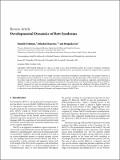| dc.contributor.author | Banerjee, Abhishek | |
| dc.contributor.author | Sur, Mriganka | |
| dc.contributor.author | Feldman, Danielle Angela | |
| dc.date.accessioned | 2016-05-09T16:35:36Z | |
| dc.date.available | 2016-05-09T16:35:36Z | |
| dc.date.issued | 2016 | |
| dc.date.submitted | 2015-12 | |
| dc.identifier.issn | 2090-5904 | |
| dc.identifier.issn | 1687-5443 | |
| dc.identifier.uri | http://hdl.handle.net/1721.1/102438 | |
| dc.description.abstract | Rett Syndrome was long considered to be simply a disorder of postnatal development, with phenotypes that manifest only late in development and into adulthood. A variety of recent evidence demonstrates that the phenotypes of Rett Syndrome are present at the earliest stages of brain development, including developmental stages that define neurogenesis, migration, and patterning in addition to stages of synaptic and circuit development and plasticity. These phenotypes arise from the pleotropic effects of MeCP2, which is expressed very early in neuronal progenitors and continues to be expressed into adulthood. The effects of MeCP2 are mediated by diverse signaling, transcriptional, and epigenetic mechanisms. Attempts to reverse the effects of Rett Syndrome need to take into account the developmental dynamics and temporal impact of MeCP2 loss. | en_US |
| dc.description.sponsorship | National Institutes of Health (U.S.) | en_US |
| dc.description.sponsorship | Simons Foundation | en_US |
| dc.publisher | Hindawi Publishing Corporation | en_US |
| dc.relation.isversionof | http://dx.doi.org/10.1155/2016/6154080 | en_US |
| dc.rights | Creative Commons Attribution | en_US |
| dc.rights.uri | http://creativecommons.org/licenses/by/2.0 | en_US |
| dc.source | Hindawi Publishing Corporation | en_US |
| dc.title | Developmental Dynamics of Rett Syndrome | en_US |
| dc.type | Article | en_US |
| dc.identifier.citation | Feldman, Danielle, Abhishek Banerjee, and Mriganka Sur. “Developmental Dynamics of Rett Syndrome.” Neural Plasticity 2016 (2016): 1–9. | en_US |
| dc.contributor.department | Massachusetts Institute of Technology. Department of Brain and Cognitive Sciences | en_US |
| dc.contributor.department | Picower Institute for Learning and Memory | en_US |
| dc.contributor.mitauthor | Feldman, Danielle Angela | en_US |
| dc.contributor.mitauthor | Banerjee, Abhishek | en_US |
| dc.contributor.mitauthor | Sur, Mriganka | en_US |
| dc.relation.journal | Neural Plasticity | en_US |
| dc.eprint.version | Final published version | en_US |
| dc.type.uri | http://purl.org/eprint/type/JournalArticle | en_US |
| eprint.status | http://purl.org/eprint/status/PeerReviewed | en_US |
| dc.date.updated | 2016-05-08T09:30:15Z | |
| dc.language.rfc3066 | en | |
| dc.rights.holder | Copyright © 2016 Danielle Feldman et al. This is an open access article distributed under the Creative Commons Attribution License, which permits unrestricted use, distribution, and reproduction in any medium, provided the original work is properly cited. | |
| dspace.orderedauthors | Feldman, Danielle; Banerjee, Abhishek; Sur, Mriganka | en_US |
| dc.identifier.orcid | https://orcid.org/0000-0001-9168-0109 | |
| dc.identifier.orcid | https://orcid.org/0000-0003-2442-5671 | |
| mit.license | PUBLISHER_CC | en_US |
